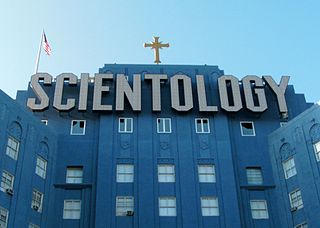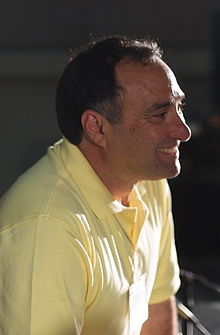
Spamming is the use of messaging systems to send multiple unsolicited messages (spam) to large numbers of recipients for the purpose of commercial advertising, non-commercial proselytizing, or any prohibited purpose, or simply repeatedly sending the same message to the same user. While the most widely recognized form of spam is email spam, the term is applied to similar abuses in other media: instant messaging spam, Usenet newsgroup spam, Web search engine spam, spam in blogs, wiki spam, online classified ads spam, mobile phone messaging spam, Internet forum spam, junk fax transmissions, social spam, spam mobile apps, television advertising and file sharing spam. It is named after Spam, a luncheon meat, by way of a Monty Python sketch about a restaurant that has Spam in almost every dish in which Vikings annoyingly sing "Spam" repeatedly.

There are a number of disputes concerning the Church of Scientology's attempts to suppress material critical of Scientology and the organization on the Internet, utilizing various methods – primarily lawsuits and legal threats, as well as front organizations. In late 1994, the organization began using various legal tactics to stop distribution of unpublished documents written by L. Ron Hubbard. The organization has often been accused of barratry through the filing of SLAPP suits. The organization's response is that its litigious nature is solely to protect its copyrighted works and the unpublished status of certain documents.
alt.religion.scientology was a Usenet newsgroup started in 1991 to discuss the controversial beliefs of Scientology and the activities of the Church of Scientology. The newsgroup became the focal point of an aggressive campaign known as Scientology versus the Internet, which took place online and in the courts.
alt.binaries.slack is a Usenet newsgroup created for the purpose of posting pictures, sounds, and utilities related to the Church of the SubGenius, making them available for everyone to see and hear. Because the Church of the SubGenius is well known for encouraging sick and twisted humor, the newsgroup is also home to artists who post humorous artwork of all sorts. A fair amount of the pictures on alt.binaries.slack are adult-oriented, and may be considered offensive by some viewers. The denizens of the newsgroup state that they enjoy deliberately offending those who are too easily offended.
Serdar Argic was the alias used in one of the first automated newsgroup spam incidents on Usenet, with the objective of denying the Armenian genocide.

Sporgery is the disruptive act of posting a flood of articles to a Usenet newsgroup, with the article headers falsified so that they appear to have been posted by others. The word is a portmanteau of spam and forgery, coined by German software developer, and critic of Scientology, Tilman Hausherr.

UUNET Technologies, Inc., formerly UUNET Communications Services, was an American commercial Internet service provider. Founded in 1987, it was one of the first and largest commercial ISPs and one of the early Tier 1 networks. It was based in Northern Virginia. Today, UUNET is an internal brand of Verizon Business.
Newsgroup spam is a type of spam where the targets are Usenet newsgroups. Usenet convention defines spamming as excessive multiple posting, i.e. repeated posting of a message or very similar messages to newsgroups. The spam may be commercial advertisements, opinionated messages, malicious files, or nonsensical posts designed to disrupt the newsgroups. A type of newsgroup spam is sporgery which is intended to make the targeted newsgroups unreadable. The prevalence of Usenet spam led to the development of the Breidbart Index as an objective measure of a message's "spamminess", and attempts to purge newsgroups of spam.
On Usenet, the Usenet Death Penalty (UDP) is a final penalty that may be issued against Internet service providers or single users who produce too much spam or fail to adhere to Usenet standards. It is named after the death penalty, as it causes the banned user or provider to be unable to use Usenet, essentially "killing" their service. Messages that fall under the jurisdiction of a Usenet Death Penalty will be cancelled. Cancelled messages are deleted from Usenet servers and not allowed to propagate. This causes users on the affected ISP to be unable to post to Usenet, and it puts pressure on the ISP to change their policies. Notable cases include actions taken against UUNET, CompuServe, Excite@Home, and Google Groups.

Google Groups is a service from Google that provides discussion groups for people sharing common interests. Until February 2024, the Groups service also provided a gateway to Usenet newsgroups, both reading and posting to them, via a shared user interface. In addition to accessing Google groups, registered users can also set up mailing list archives for e-mail lists that are hosted elsewhere.
Comment spam is a term referencing a broad category of spambot or spammer postings which abuse web-based forms to post unsolicited advertisements as comments on forums, blogs, wikis and online guestbooks. Related topics include:
Usenet II was a proposed alternative to the classic Usenet hierarchy, started in 1998. Unlike the original Usenet, it was peered only between "sound sites" and employed a system of rules to keep out spam.
A cancelbot is an automated or semi-automated process for sending out third-party cancel messages over Usenet, commonly as a stopgap measure to combat spam.
Christopher Lewis is a Canadian computer security consultant from Ottawa, who fought spam on Usenet and the early Internet. Active in volunteer anti-spam efforts in the late 1990s and early 2000s, Lewis was described in Net.wars (1997) as "the best known active canceler of spam and other mass postings" at the time. In April 1998, he organized an unsuccessful moratorium with forty other anti-spam volunteers in an attempt to boycott internet service providers into doing their share against spam. He worked as a systems architect for Nortel and, as of 2017, is Chief Scientist at SpamhausTechnology.
A Usenet personality was a particular kind of Internet celebrity, being an individual who gained a certain level of notoriety from posting on Usenet, a global network of computer users with a vast array of topics for discussion. The platform is usually anonymous, although users can get celebrity status, usually by being deemed different from other posters in some way.

Make Money Fast is a title of an electronically forwarded chain letter created in 1988 which became so infamous that the term is often used to describe all sorts of chain letters forwarded over the Internet, by e-mail spam, or in Usenet newsgroups. In anti-spammer slang, the name is often abbreviated "MMF".

Usenet, USENET, or, "in full", User's Network, is a worldwide distributed discussion system available on computers. It was developed from the general-purpose Unix-to-Unix Copy (UUCP) dial-up network architecture. Tom Truscott and Jim Ellis conceived the idea in 1979, and it was established in 1980. Users read and post messages to one or more topic categories, known as newsgroups. Usenet resembles a bulletin board system (BBS) in many respects and is the precursor to the Internet forums that have become widely used. Discussions are threaded, as with web forums and BBSes, though posts are stored on the server sequentially.
The history of email spam reaches back to the mid-1990s when commercial use of the internet first became possible - and marketers and publicists began to test what was possible.
The Meow Wars were an early example of a flame war sent over Usenet which began in 1996 and ended circa 1998. Its participants were known as "Meowers". The war was characterized by posters from one newsgroup "crapflooding", or posting a large volume of nonsense messages, to swamp on-topic communication in other groups. Ultimately, the flame war affected many boards, with Roisin Kiberd writing in Motherboard, a division of Vice, that esoteric Internet vocabulary was created as a result of the Meow Wars.







